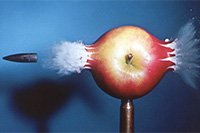The father of the flash: Tracing the modern flash back to its scientific beginnings
posted Friday, February 10, 2017 at 7:00 AM EDT

A few years ago, BBC Future wrote a feature about Harold Eugene Edgerton, a longtime electrical engineering professor at Massachusetts Institute of Technology and pioneer of flash photography. A post on Reddit about Edgerton recently appeared, so it feels like a great time to take a look back at his work and the lasting influence he had.
Edgerton was born in Nebraska in 1903. Early in his education, he began using an electronic flash to capture images of everyday objects. His photographic work didn’t garner much attention until 1937 when Edgerton began working with photographer Gjon Mili. Edgerton and Mili used flash to create many images which were featured in Life Magazine. Edgerton was a visionary when it came to using short duration flash to capture action photographs.
The idea for using split-second flashes of light to freeze action originated when Edgerton noticed that a warning light on a computer he was using for an experiment while studying at Massachusetts Institute of Technology was blinking so fast that it made moving parts of a motor appear to be stationary. Per BBC, “In those days, there were no high-speed films allowing you to shoot with ambient light unless you used a shutter speed lasting many seconds - pretty useless unless your subject was stock still. Flash was vital in giving enough light for these 'slow' films to capture moving objects.”
Using a bulb filled with mercury which was connected to a battery, Edgerton used the current to excite the gaseous mercury, which resulted in a flash of light. By adjusting the power, the duration of the flash could be varied. Further, because it relied on a battery current, the flash could be used repeatedly. Edgerton called his invention the stroboscope. It wasn’t until Edgerton swapped the mercury gas out with xenon that his design became practical and marketable. Still, Kodak was skeptical, so Edgerton took his strobe to a boxing match, captured a photo and wired it to newspapers and “The age of the electronic flash was born.”
Beyond sports and action photography, Edgerton also devised very large versions of his flash which were used for surveillance during World War II, likely saving the lives of many paratroopers as they entered into verifiably clear drop zones in Normandy during the Allied assault on advancing German troops.
Following the war, Edgerton created the Rapatronic camera. This highly-specialized camera offered the fastest shutter speeds of any camera at the time, a very fast 1/4,000,000th of a second, allowing Edgerton and other scientists to capture the initial stages of an atomic explosion.
Although he created many excellent images, some of which garnered photographic awards, Edgerton always considered himself an engineer rather than an artist. “Don’t make me out to be an artist. I am an engineer. I am after the facts. Only the facts.”
It is difficult to overstate how important Edgerton’s advances in flash photography really were. He was the first person to use electricity to freeze time and modern high-speed photography can be traced back to him. Colin Harding, a curator at the UK’s National Media Museum, said of Edgerton’s work, “He captured wonderful, captivating images that transcend the boundaries between science, art and entertainment.”
Whenever you use flash, be it on your camera or on the smartphone in your pocket, you owe Harold Edgerton a debt of gratitude. To see more of his work, see here.
(Seen via Reddit)